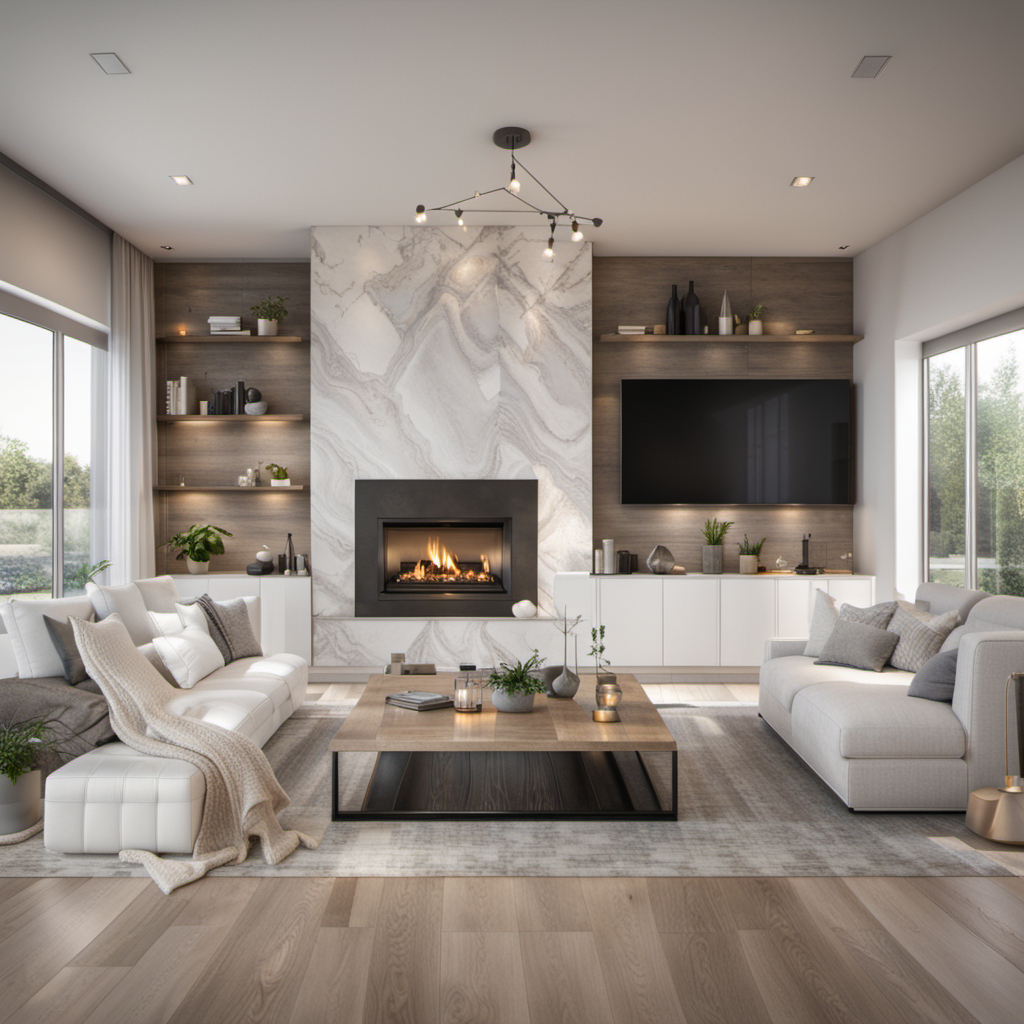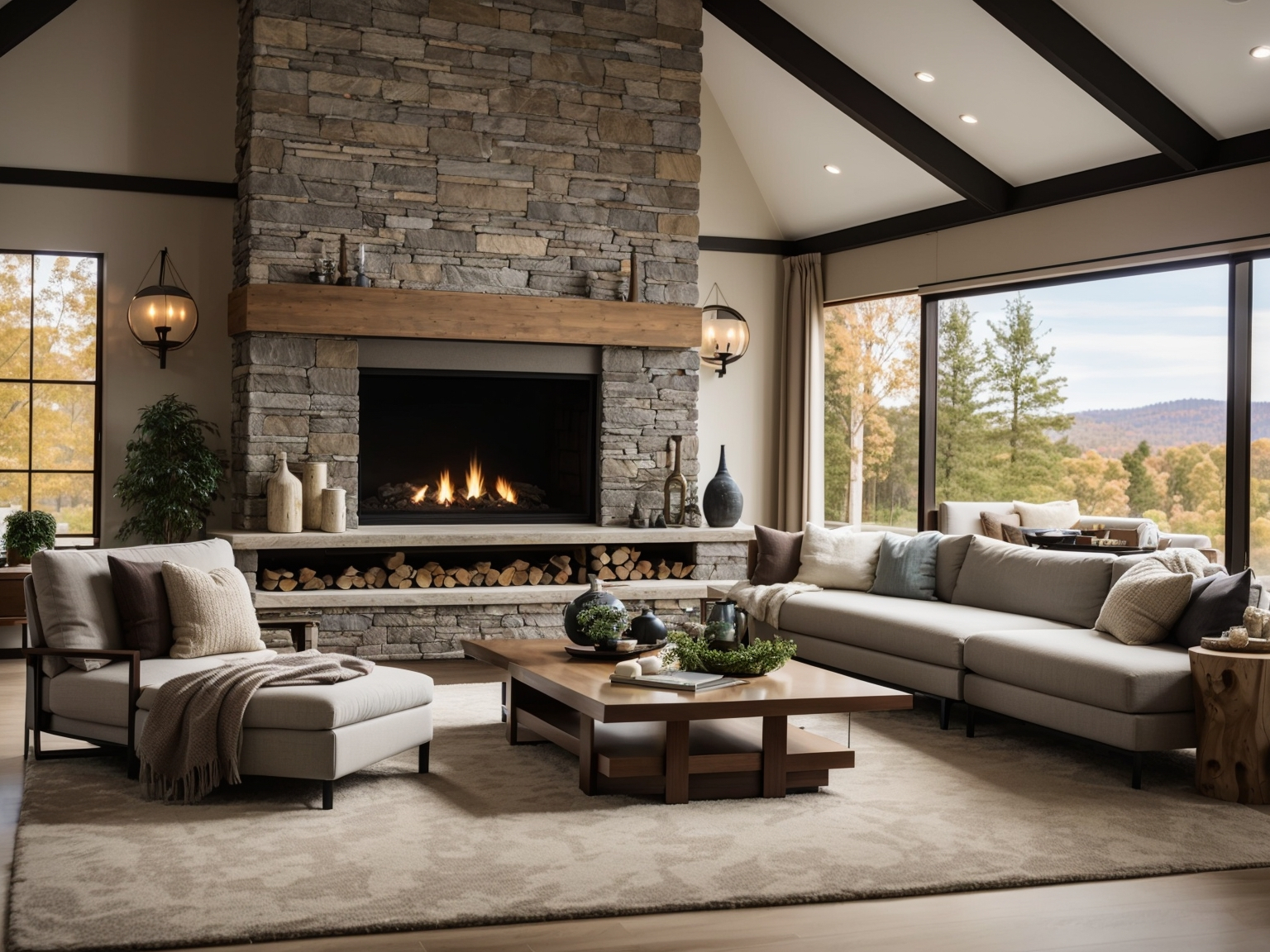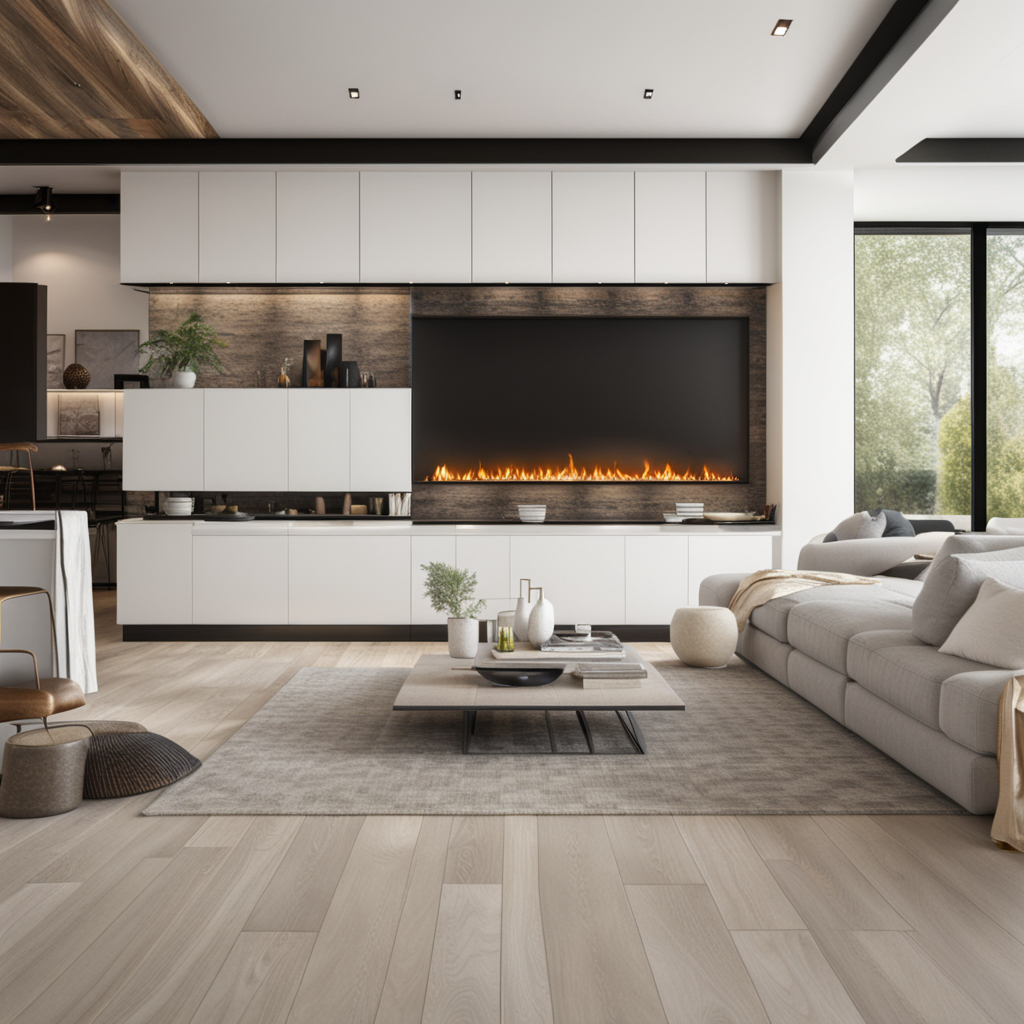Keys to Create a Cozy Ambiance with a Floating Wall Unit Fireplace
A floating wall unit with a built-in fireplace infuses style and warmth into any living space. These multifunctional furnishings marry the striking visual of flickering flames with the practicality of storage, shelving, and media capabilities. As we evaluate options to make our homes both beautiful and livable, this creative design seamlessly blends form and utility.
In the article below, we explore the versatility and benefits of incorporating fireplaces into wall units. You’ll find insights on sizing, ventilation, material and style choices to seamlessly integrate one into your décor. We cover safety tips for careful operation plus maintenance needs to preserve its function.
Our goal is to provide helpful knowledge so you can confidently plan this eye-catching addition. With the information here, you can unlock the full potential of this furnishing to create a focal point that delivers ambiance, organization, and style to your living room.
Size and Placement Considerations
Determining the right size and placement for your floating wall unit fireplace is key to maximizing its visual impact while ensuring proper functionality. With some planning and forethought, you can create the perfect built-in look to enhance your living space beautifully.
When evaluating size options, first look at the dimensions of your room. A unit that is too small risks getting dwarfed by the surrounding area. However, an oversized piece can feel imposing.

Layout Possibilities
Consider if you want your unit as a full wall installation or a recessed look. Full wall units make a dramatic statement, with the fireplace and shelving extending edge to edge. Recessed units have a more subtle effect, nestled partly into the wall.
For smaller spaces, a horizontal rectangular shape can give the illusion of width. A vertically oriented layout works well in rooms with high ceilings, drawing the eyes upwards.
You also have a choice between a built-in or freestanding unit. Built-ins appear seamlessly integrated into the wall, with a custom look. Freestanding units have a furniture style, which allows for flexibility in placement.
Prime Placement
When determining placement, avoid pushing your unit into a corner or periphery of the room. Centering it on the focal wall creates the best sightlines for enjoying flickering flames from seating areas.
Place lounge chairs and sofas around the fireplace to create an inviting conversation area. TV watching also benefits from the soft glow and warmth an electric or gas fire provides.
For traffic flow, be sure to allow adequate clearance around the unit. Avoid blocking entrances, pathways or windows.
Ventilation Needs
Proper ventilation is crucial for a wall fireplace, whether electric or gas. Combustion types require venting to the outside to remove exhaust gases and moisture. Even ventless gas units need airflow to disperse heat.
Consult your installer on ducting and vent requirements based on your unit, its sizing and placement in the home. Vents should channel to the roof or exterior wall while avoiding structural obstructions.
Design Styles
Consider your room’s decor when selecting a style. Sleek metal frames and glass facades work for contemporary spaces. Stacked stone surrounds or exposed brick has a rustic feel. Go for an industrial look with a steel frame and metal mesh front.
Let your wall unit fireplace reflect your personality while complementing the furnishings around it. With customization options and various looks available, you can achieve the perfect cozy ambiance.
Electric vs Gas Fireplace Options
When planning your floating wall unit fireplace, one of the biggest decisions is whether to go with an electric or gas model. Each has pros and cons to weigh regarding heating ability, aesthetics, operating costs and technical requirements.
Heating Capabilities
In general, gas fireplaces provide stronger heating output, capable of warming rooms up to 1,000 square feet. The combustion process generates substantial heat to supplement your home’s central system. Intricate logs, flickering flames and smoke effects add realism.
Electric fireplaces offer lower levels of radiant and ambient warmth from the glowing embers or crystals. They are ideal for zone heating smaller spaces like bedrooms or offices. Newer LED technology mimics the look of fire and logs.
For both types, heat output depends on the model’s BTU rating and size. Determine the heating needs of the space before deciding which performs best.
Aesthetics and Style
Beyond heating ability, the style of the flame effects and log sets differs aesthetically between gas and electric.
Gas fireplaces have inherently organic, lifelike flames and smoldering logs, with deep glow and shadows. The fire moves and dances naturally for an authentic campfire feel.
Electric models allow for more abstract, modern styles like crystals or river rocks with underlighting. For a traditional look, flickering LEDs may recreate fake logs. Wall colors can also project flames.
Gas fireplaces lend themselves to rustic, farmhouse or traditional decors that benefit from a realistic fire aesthetic. Electric models suit contemporary, modern or transitional spaces.
Operating Costs and Maintenance
Operating costs are another major difference. Gas fireplaces consume fossil fuels while electric models operate on standard household power.
Gas units require venting and annual inspections. Electric models only need an initial hardwire installation. Along with lower energy use, they do not need chimney maintenance.
For gas fireplaces, inspecting and cleaning the glass screen, replacing logs, and clearing exhaust buildup may be needed. Electric units just require replacing bulbs and cleaning effects like faux crystals occasionally.
Electrical Wiring Needs
Gas fireplaces may require some wiring for blowers, fans and lighting features. However, electric models have extensive wiring needs for operation.
Consult your electrician on wiring capacity. Typical requirements are:
- 110/120 volt circuit
- Dedicated 15 amp grounded outlet
- Hardwired connection behind unit
- Surge protection recommended
Factor electrical work into your total installation budget. Proper planning ensures your floating fireplace has the power supply to match the mood and ambiance you desire.
Material and Design Choices
The materials and finishes you select for your floating wall unit fireplace can enhance its style beautifully. Natural wood evokes warmth while sleek glass and steel create a modern statement. Consider how each design choice contributes to your desired atmosphere.

Frame Materials
The inner framework that provides structure is rarely visible, but still impacts durability and cost. economical wood frames suit most budgets well. Go for metal or steel for maximum strength and a contemporary vibe.
Stone like granite or manufactured concrete can complement surfaces like brick or stacked stone. Discuss framework options with your builder to ensure it supports the unit’s proportions and finish materials.
Front Facing Materials
The outward facing surfaces make the biggest aesthetic impact. Tile offers endless colors and patterns, like metallic subway tiles or textured stone. Glass fronts read sleek and modern. Panel accent walls behind the unit in shiplap or reclaimed wood add rustic charm.
Consider surrounding architectural details when selecting finishes. For example, go for an open shelf design to highlight an exposed brick wall. Maintain sightlines to other features like large windows or artwork.
Design Styles
Your choice of materials influences the overall design style your wall unit fireplace conveys.
Industrial styles use distressed wood, black metal and exposed framework. A contemporary look relies on clean lines, glass and light finishes like white lacquer.
Frame reclaimed beams or stacks of stone for a cozy farmhouse statement. The options are unlimited for infusing your personality.
Customization
While many retailers offer prefabricated units, customization is key for a built-in look. Modify dimensions, shelving configurations, and trims to fit your space perfectly. Integrate personalized touches like monogrammed hardware or carved decorative accents.
Storage and Media Features
Beyond housing the fireplace itself, floating wall units present possibilities to integrate storage, shelving and media displays. This maximizes their functionality within your living space.
Wall units can incorporate cabinets and shelves above, beside or below the fireplace installation. Built-in shelving provides spots to display cherished photos, artwork and decor. Open shelves keep remotes, coasters and TV accessories organized while adding visual interest.

Shallow cabinetry built around the firebox offers discreet storage for components like cable boxes or DVD players. Opt for cabinets with glass fronts to allow device remotes to work. Side cabinets give space for storing firewood and cleaning supplies out of sight.
Consider your media needs as well. Wall units commonly integrate mounting brackets for flat panel TVs, allowing wires and components to remain hidden. Place your television above the mantel for the perfect viewing angle.
For a large media console look, opt for a longer unit with the fireplace on one end and cabinets for AV equipment on the other. Add shelving to display your movie collection.
Floating wall units with fireplaces maximize function through smart storage and media inclusion. Keep remotes, consoles and clutter neatly tucked away while you enjoy the cozy ambiance. Achieve a furnished look without any floor space needed.
Safety Tips and Precautions
While fireplaces boost ambiance, they also require care and caution to operate safely. Take proper precautions with your floating wall unit fireplace so you can enjoy it for years to come.
First, have your installer follow all clearance specifications from the manufacturer. There should be adequate space between the fireplace and any combustible materials, like wood trim or wallpaper. Non-combustible surrounds like stone or metal should be placed near flames.
For both gas and electric models, a protective screen or guard prevents direct contact with the fire. Choose screens made of durable wrought iron or framed glass to contain any sparks or embers within the fireplace while preserving the view.
Of course, operational fireplaces call for working smoke and carbon monoxide detectors installed in the home. Place them near bedrooms and hallways to provide alerts in case of any leaks or malfunctions. Test them monthly and replace batteries regularly.
Supervise children and pets closely whenever the fireplace is on. Establish firm rules against touching hot surfaces. Consider locking fireplace controls if necessary to avoid accidental activation. Never leave the space unattended with the fireplace operating.
Incorporate other childproofing as well, like anchoring any wall-mounted shelving. Straps and brackets keep items securely on the unit. Corner cushions on sharp edges prevent any injuries.
Costs and Where to Purchase
Investing in a gorgeous floating wall unit fireplace brings tremendous value while transforming your living space. But what should you budget for this eye-catching addition? We’ll overview cost factors and shopping tips.
Prices vary based on size, features and materials. Here are typical ranges:
- Electric fireboxes – $500-$1500
- Electric units with shelving – $2000-$4000
- Custom built-in gas units – $4000-$15,000
Larger, more intricate units with premium finishes like stacked stone and custom woodworking increase costs.
Key Cost Factors
- Size: Larger units are more expensive. Measure your space carefully.
- Materials: Real wood, tile and stone raise prices over laminates and metals.
- Installation: Built-ins require more labor than freestanding units.
- Venting/Wiring: Gas lines, chimneys, and electrical work add $2000+
- Features: Storage, media consoles, and custom finishes add cost.
Watch for sales on floor models and clearance items. Conversely, custom work and rare woods can increase prices.
Where to Buy Floating Wall Unit with Fireplace
Online retailers like Wayfair offer mass-produced electric models at lower price points. Visit showrooms to see higher-end gas fireplaces.
Local specialty stores provide a hands-on experience and customization services. Discuss your budget and vision to find the right options.
Sourcing the unit in phases can maximize choices while controlling costs. A carpenter can then handle assembly and finishes.
With planning and smart shopping, you can stay on budget for your dream fireplace. Make this striking focal point a reality!
Professional Installation Process
While floating wall units offer a streamlined look, their installation is best left to professionals. There are several technical steps involved, especially for gas fireplaces.
A certified installer will handle the gas line connection and venting ductwork. Gas fireplaces require proper exhaust venting, often through an existing chimney or new roof ducts. There may also be air intake needs as well.
Electric fireplaces need significant wiring work too. Electrical experts can integrate the proper dedicated outlet and surge protection behind the unit. Running new circuits may be necessary to support lights and media components.
Structurally, the unit must be very securely fastened to wall studs, often using heavy-duty brackets and supports. Load-bearing strength prevents any chance of collapse. Reinforced mounting is especially important in homes with children.
For the most seamless built-in look, surrounding finishes will be installed right up to the fireplace frame. The pros can blend trimwork and wall surfaces beautifully.
Of course, reputable installers will ensure the unit meets all local building codes and manufacturer clearances. Permits may be required for gas line work. Don’t cut corners here.
Hiring a seasoned fireplace specialist gives peace of mind and protects your investment. Pay a little more for excessive skills and experience. Then enjoy your new showpiece for years of warm, worry-free operation.
Maintaining and Cleaning Your Unit
A gorgeous floating wall unit fireplace remains an eye-catching focal point when properly maintained. Follow these tips to preserve its beauty and function for years.
For glass fronts, use a specialty cleaner formulated for fireplace glass. These remove soot and whitish deposits from combustion flakes. Avoid abrasive pads which can scratch. Wipe down any metal or chrome trim as needed.
Check manufacturer guidelines, but replacing interior components like logs or crystals is generally only needed every 2-3 years. Order replacements directly from the company.
Gas Fireplace Care
Gas fireplace vents and chimneys require annual inspection and cleaning. Hire a chimney sweep to brush and vacuum the flue, damper and termination cap. Catch any blockages early.
Visually check the pilot assembly and burners for proper flame patterns, discoloration or corrosion. Make repairs immediately as issues can impact safety.
Electric Fireplace Upkeep
Clean fan inlets and outlets seasonally using a vacuum crevice tool. Dust buildup affects heat distribution and performance.
Inspect wiring connections, checking for any loose plugs or damage to cords. Faulty wiring presents a fire hazard.
Routine Inspections
Periodically inspect mounting brackets and wall connections. Tighten any loose hardware immediately to prevent unit detachment.
Confirm childproofing features like tip restraints and corner guards remain in place. Replace any missing safety items.
Stay on top of care and your fireplace will provide cozy ambiance for years. But don’t let required maintenance intimidate you. We’re here to help make the process simple.
Our blog provides all the information needed to properly operate and care for your new fireplace. Reach out anytime for personalized tips and guidance! We hope to help you maximize the beauty and joy this special addition brings.